
A Detailed VPNa Fake GPS Location Free Review On Xiaomi Redmi K70 Pro | Dr.fone

A Detailed VPNa Fake GPS Location Free Review On Xiaomi Redmi K70 Pro
As I stumbled upon this query that has been recently posted on a leading online forum, I realized that so many people don’t know about the VPNa Fake GPS app. If you are also an Android user who would like to change your device’s location, then VPNa Fake GPS APK might meet your requirements. Since there are so many location spoofing tools out there, I decided to give VPNa Fake GPS location app a try and have come up with its genuine review here.
Part 1: VPNa Fake GPS Location Free: Features, Pros, Cons, and More
Developed by XdoApp, VPNa Fake GPS is a popular application that can change the location of your Android virtually. Using it, you can spoof your device location to almost anywhere in the world. This would be reflected in almost all the installed gaming, dating, and other apps on your phone automatically.
- You can look for any location on the interface of VPNa Fake GPS by entering keywords (name/address) or the exact coordinates (longitude and latitude) of the place.
- To fake GPS using VPNa, you would be presented with a map-like interface and can easily move the pin around to spoof your location to an exact place.
- Besides that, if there is a location that you change frequently, then you can also mark it as a favorite.
- The VPNa fake GPS location APK would also maintain the record of the past locations that you have spoofed.
- Using VPNa Fake GPS, you can change your location as many times as you want without paying anything.
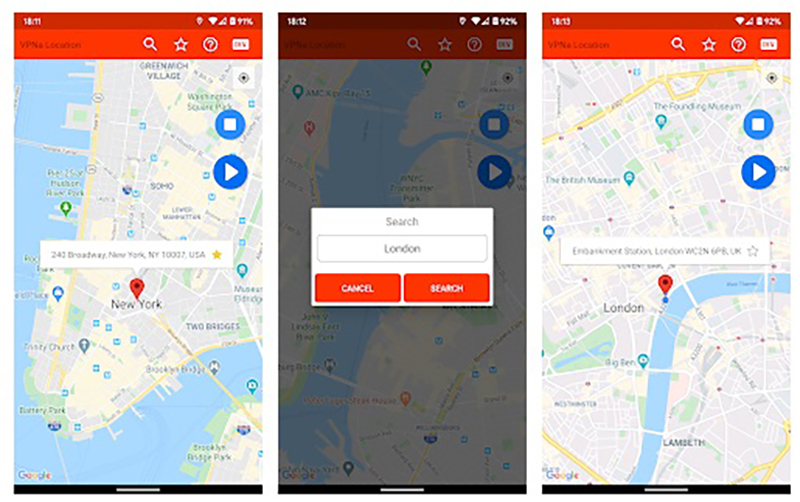
Pros
- The changed location would be reflected in almost every dating and gaming app.
- The basic version of VPNa Fake GPS is available for free and doesn’t need root access.
- The overall interface of VPNa Fake GPS APK is pretty user-friendly and smooth.
Cons
- At times, some advanced apps (like Pokemon Go) can detect it and might get your account banned.
- While using the free VPNa fake GPS version, you would get in-app ads.
- Sometimes, the location is not spoofed even after consecutive attempts.
Pricing: While you can access the basic version of VPNa Fake GPS for free, you can pay $2.99 for an ad-free experience.
Compatibility: Android 4.4 and newer versions
Play Store Rating: 3.6/5
Important Note
Don’t get confused by the name of VPNa Fake GPS as it is not a VPN, but only a location spoofing solution. If you are looking for a VPN app, then you should consider other options.
Final Verdict
Overall, VPNa Fake GPS location free is worth a try. It is pretty lightweight, easy-to-use, and supports almost all the prominent apps. Since you don’t have to pay anything to use VPNa Fake GPS, you can give it a try, and explore it on your own.
Part 2: How to Use VPNa Fake GPS Location Free to Spoof Your Location?
Now when you know how VPNa fake GPS Location Free works, let’s quickly understand how to use it to change the location on any Android phone.
Step 1: Enable Developer Options on your phone
To set up a mock location app, you need to first enable the Developer Options on your device. To do this, just go to its Settings > About Phone and tap on the “Build Number” feature 7 consecutive times.
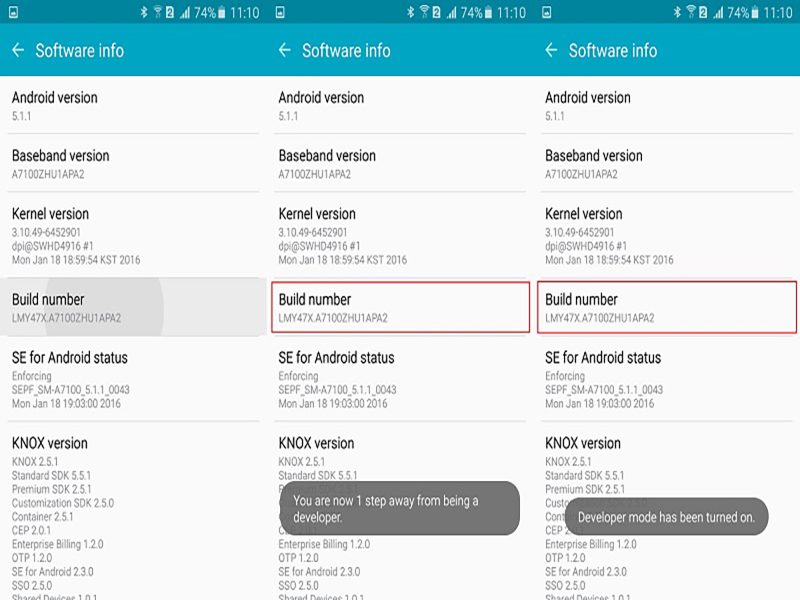
Once it is done, go to its Settings > Developer Options and turn on the option to set a mock location on your phone.
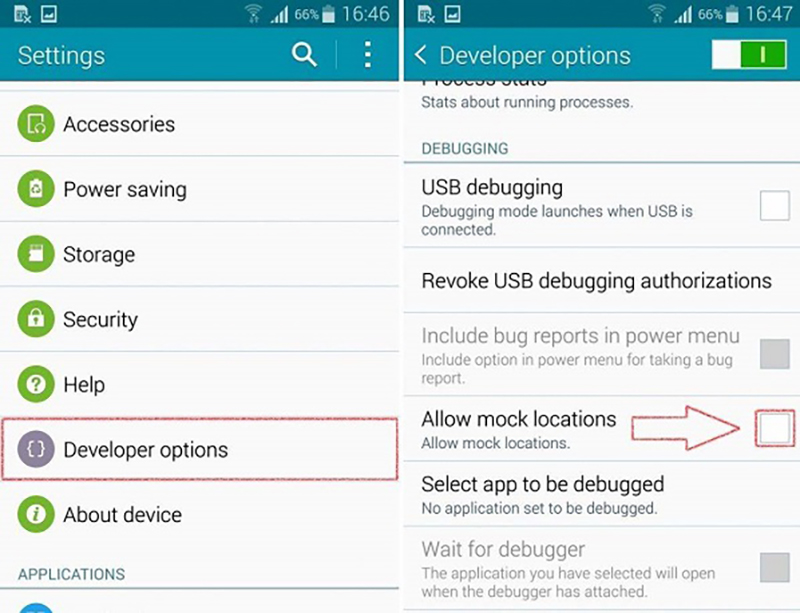
Step 2: Make VPNa Fake GPS as the default mock location app
Now, you can just go to the Play Store and download the VPNa Fake GPS Location app on your device. After the app is installed, you can just go to its Developer Options again and set it as a default mock location app.
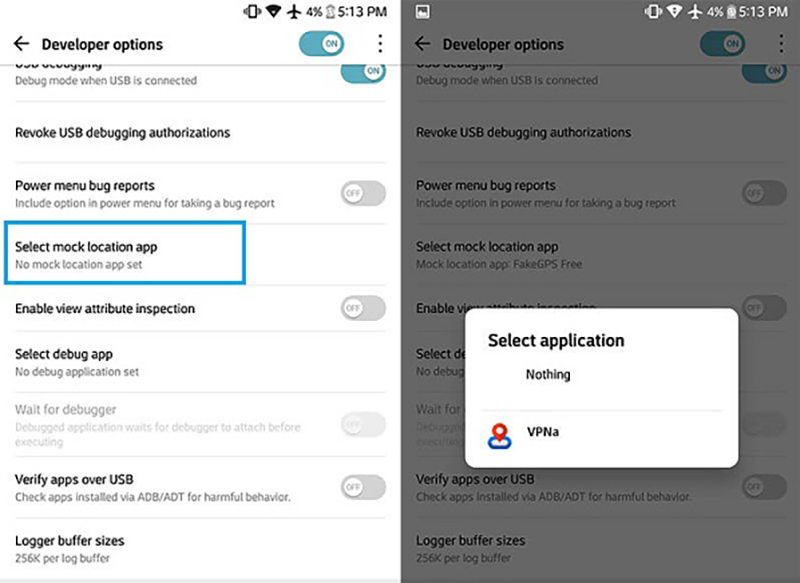
Step 3: Spoof your Android’s location
That’s it! Whenever you wish to change the location of your device, simply launch VPNa Fake GPS APK. You can enter any location’s address or coordinates in the search bar and wait for it to be loaded on the interface.
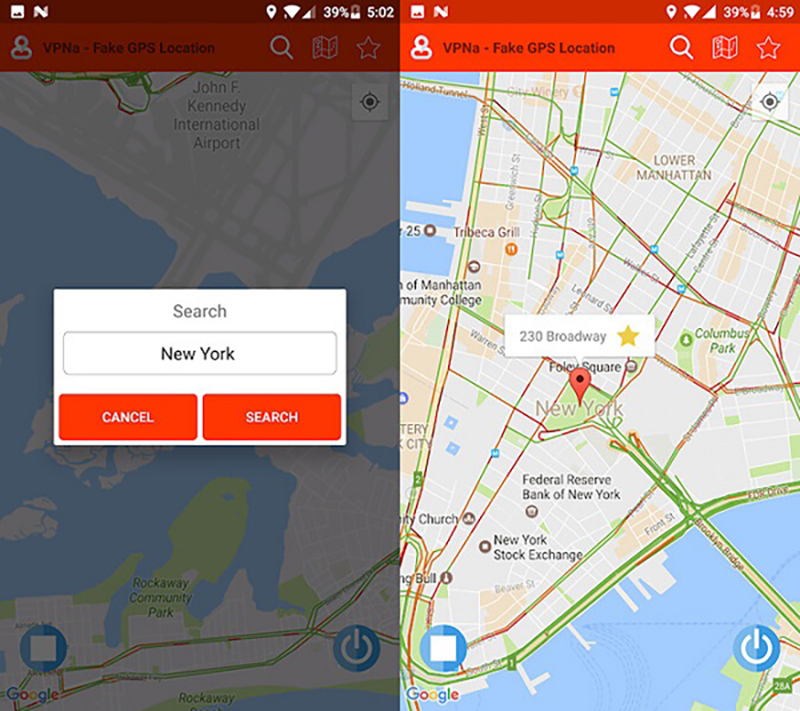
Later, you can move the pin around and drop it anywhere you like. Tap on the Start button and confirm your choice to spoof your device’s location.
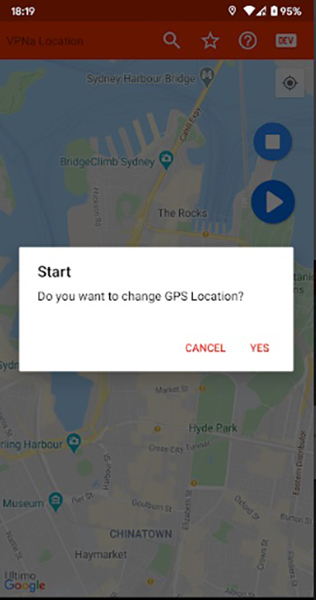
Part 3: Bonus Tip: How to Spoof an iPhone Location without Jailbreak
While Android users can take the assistance of VPNa Fake GPS, iOS users often find it hard to change their device location. Well, in this case, you can consider Dr.Fone - Virtual Location(iOS) . It is a user-friendly application that can spoof your iPhone location to any other place by entering its address or exact coordinates. Besides that, you can also simulate the movement of your device between different spots.
Step 1: Connect your iPhone and launch the tool
At first, you can just connect your iPhone to your computer and launch the Dr.Fone toolkit. Select the “Virtual Location” feature from its home and click on the “Get Started” button.

Step 2: Look for a location to spoof
The application will automatically detect your device’s location and would display it. To change it, click on the Teleport Mode icon from the top, and enter the address/coordinates of the place in the search bar.
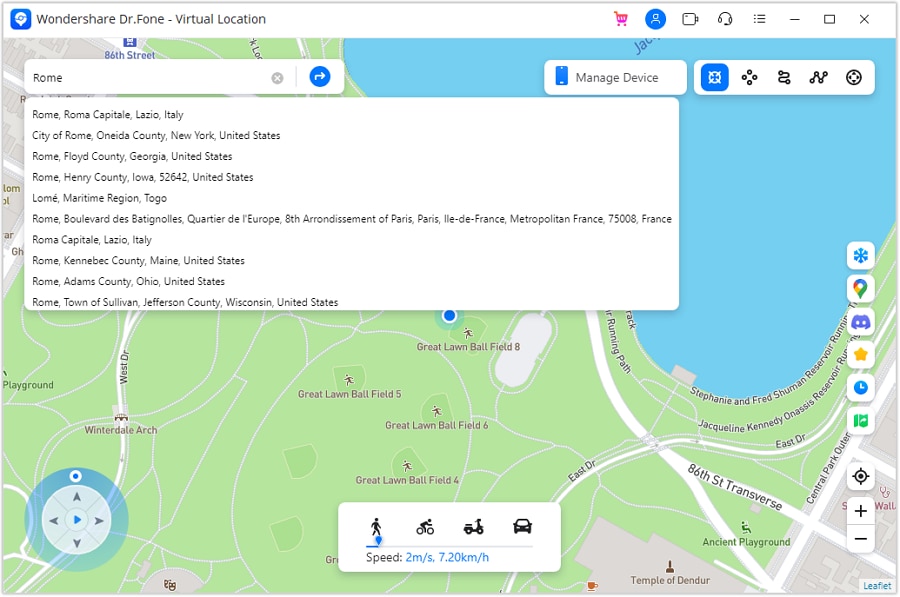
Step 3: Change your iPhone’s location
After entering the target location, the interface would also change. You can move the pin, zoom in/out, and drop it to the designated place. In the end, just click on the “Move Here” button to spoof your iPhone’s location.
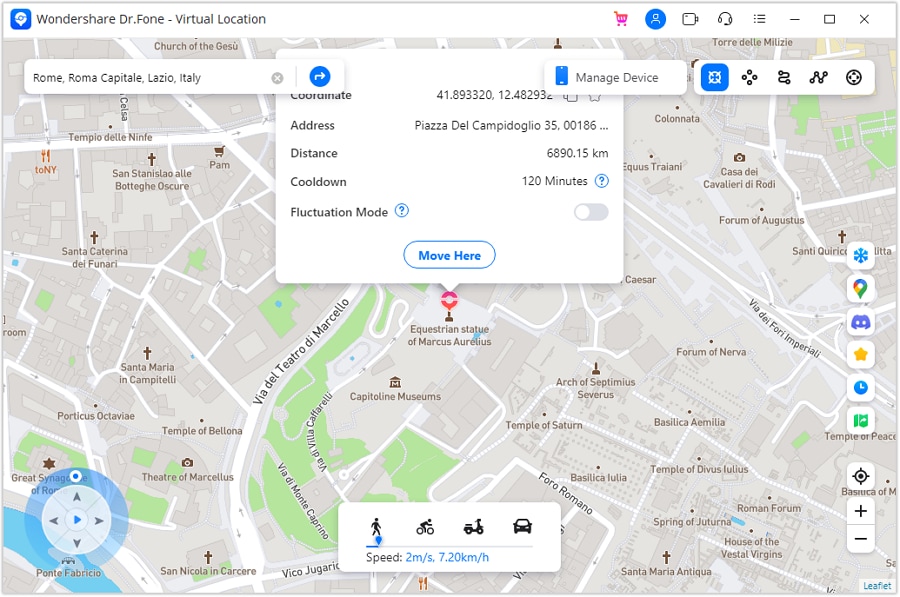
This brings us to the end of this detailed VPNa Fake GPS Location Free review. To help you use the VPNa Fake GPS APK, I have listed its features, pros, cons, and even a detailed tutorial. On the other hand, if you are an iPhone user, then you can simply use Dr.Fone - Virtual Location(iOS) and change your device’s location to anywhere you want.
How to Stop Google Chrome from Tracking Your Location On Xiaomi Redmi K70 Pro?
Do you know your web browser is continually sharing your actual location online? You might not have noticed, but the number of websites using your location has increased. As you are well aware of the dangers of the internet, it doesn’t make sense to turn your Chrome into a beacon for ill-intentioned people. Luckily, it is possible to fake a location on Chrome with the right tool.
Are you wondering how to fake the browser location or which tool to use? You can get all your answers by reading this article till the end.

Part 1: How Does Chrome Know Your Location?
Before discussing Google Chrome’s fake location, it is important to know how Chrome detects your physical location. Google Chrome uses many ways to pinpoint your exact location, like your IP address, GPS, Wi-Fi, Bluetooth, and Cell Tower data. Every internet connection has an IP address bound to a location that enables Chrome to identify your location.
Similarly, GPS location can easily be tracked if your phone device has it enabled. All the Wi-Fi and Bluetooth connections around you also have location information embedded in them. They can help Chrome track you as long as your device can detect them. If you use cell data, Google Chrome can also track you through cell towers.
Part 2: How to Hide Location Services in Chrome?
If you are worried about Google Chrome detecting your physical location and sharing it with websites and apps, you can hide it easily. The process of hiding your location on Google Chrome is simple, even if you are using multiple devices. Below is the step-by-step process of hiding location services in Google Chrome on computer, Android, and iOS devices.
Method 1: For Laptop and Desktop PCs
Step 1: Launch Google Chrome on your computer and click the “Three Dots” icon to open the Google Chrome Settings. Here, tap “Privacy and Security” from the left sidebar and select “Site Settings.”

Step 2: Navigate to “Permissions” and click on “Location.” To hide the location on Google Chrome, select the “Don’t allow sites to see your location” option.

Method 2: For iPhone or iPad
Step 1: Navigate to “Settings” on your iPhone and open it. Scroll down until you find the “Chrome” app option and select it.

Step 2: Press “Location” on the next screen to open the location options for Google Chrome. Here, choose “Never” to stop Google Chrome from detecting your location.

Method 3: For Android
Step 1: Open Google Chrome on your Xiaomi Redmi K70 Pro, press the “Three-Dots” icon, and tap “Settings” from the options.

Step 2: In Chrome Settings, press “Site Settings.” Now select “Location” and hide your location by toggling off the “Location” option.

One way to protect your privacy and stop websites from tracking your location is to turn off the location, but it has many disadvantages. If you have turned off your location, you can’t use any location base service like food delivery, e-shopping, ride-sharing, etc. That’s why it is better to use a fake location on your browser. Below we have explained four methods for Chrome fake location.
Method 1. Best Tool to Fake Chrome Location On iOS and Android Phones
The easiest and quickest way to fake your location on Google Chrome is to use Dr.Fone - Virtual Location . Since smartphones contain a wide range of apps that require location access, it provides a stable way to fake Chrome locations on Android and iOS phones. No website or app will be able to detect that you are using a fake location when using Dr.Fone - Virtual Location for faking GPS location.
Key Features
- Dr.Fone - Virtual Location can be used for any social media app like Facebook, Twitter, or Instagram with a fake location.
- With the help of this tool, you can also spoof real-time tracking apps like Life360 to protect your privacy.
- If you are an iPhone user, you don’t have to jailbreak your iPhone to spoof your device’s location.
How to Fake Chrome Location On iOS/Android Phones via Dr.Fone - Virtual Location
Faking your Chrome location with Dr.Fone - Virtual Location is very straightforward. You only need the Dr.Fone mobile toolkit and a USB cable to connect your Xiaomi Redmi K70 Pro. Follow these steps to spoof Chrome location on Android and iOS phones:
Step 1: Connect Your Android/iOS Device to Your Computer
Connect your Android or iOS phone to your computer using a USB cable. Launch the Dr.Fone robust toolkit on your computer and select “Virtual Location.”

Step 2: Activate the Teleport Mode
Press “Get Started” on the next page to open the map window. First, select your actual location by pressing the “Center On” icon from the right sidebar. Afterward, click on the “Teleport” icon from the top right corner to activate the Teleport Mode.
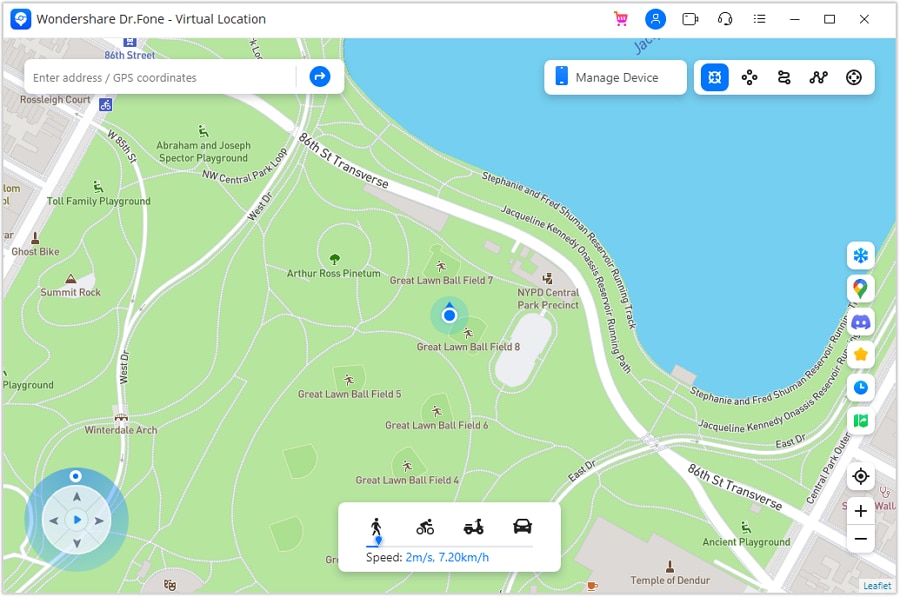
Step 3: Add the Desired Fake Location
Once the Teleport Mode is activated, add your desired location and press “Go.” Your desired location will open on the map. Select it, and a pop-up window will appear where you need to press “Move Here.” With that, your Android or iPhone’s Chrome location has been changed.

Method 2. Manually Change Your Location Using Google Chrome DevTools
It is also possible to fake browser location on Chrome using the Google Chrome Developer Tools. It is a built-in feature of Chrome and can be used to manually change or turn off your browser’s location. Follow these steps for changing location on Chrome with DevTools:
Step 1: After opening Google Chrome, click the three-dots icon from the top right corner. It will open the Chrome menu where you need to select “Developer Tools” after clicking “More Tools.”

Step 2: A window will open on the right side with all the developing tools you can use in Chrome. Click on the three-dots icon located near “Console” in the bottom left corner of the window. Choose “Sensors” from the pop-up menu.

Step 3: Access the newly selected “Sensor” option, and here you can change the browser’s location by either selecting a Google’s pre-set location or adding your desired location manually. Once the location is selected or added, your browser’s location will change.

Limitations
- The interface of the Google Chrome DevTools can be very confusing and overwhelming for non-technical users.
- Apart from pre-added locations, it can be hard to add a specific location as your fake location.
Method 3. Fake Your Location Using Chrome Extension
Many fake location Chrome extensions are available on Google Chrome which can be used to alter your location on Chrome. You can find these extensions on Google Chrome Web Store and add them directly to your browser. Below we have explained the steps for using such an extension “Location Guard “ to fake your location on Google Chrome:
Step 1: Open the “Location Guard” on Chrome Web Store and click “Add to Chrome” to add it to your browser. Once the “Location Guard” extension is added, open it and press “Options.”

Step 2: In the options, you can choose different options like Privacy Levels, Protection Area, and Time for Location Cache. It is recommended you choose a higher level for more protection.

Step 3: You can also use the “Fixed Location” feature to set up a fake location as a permanent location for your browser. The fixed location can be added by using the market or clicking on the desired place on the map.

Limitations
- Location Guard doesn’t protect your IP address. It means some websites can still detect your real location using the IP address.
- The app is not updated for quite a while, that’s why the map of the fixed location feature is quite restricted.
Method 4. Spoof Your IP Using a VPN Server
Another way you can fool websites and your browser by displaying a fake location online is to use a VPN server. VPNs fake your IP address to fool websites and apps into detecting your location. NordVPN is a VPN that can be used to spoof your IP by following these steps:
Step 1: Download and install NordVPN on your computer or phone and log in using your account. If you don’t have a NordVPN account, you must create one first.
Step 2: If you want to just change the location of your device, you can select “Quick Connect.” Using it will enable the program to automatically find the most suited fake location for you.

Step 3: You can also choose the desired location as your fake Chrome location in NordVPN. To do that, scroll down the list of countries and locations and choose your desired locations to connect to.
Limitations
- NordVPN can only spoof your IP address and will not work for geo-restricted applications.
- Using a VPN usually affects your internet speed and can make browsing slower and more difficult.
Part 4: FAQs
1.What is Geolocation?
Geolocation is a term used for the process of pinpointing the location of a device connected to the internet. The location can be determined using methods like IP address, GPS, and mobile tower data. Apps and websites commonly use it to provide location-based services.
2.What is the HTML5 Geolocation API?
The HTML5 Geolocation API is a browser API used to determine a user’s geographical location. Developers use it to build location-aware websites and apps that use users’ locations as the basis for providing their services. It can detect location through GPS, Wi-Fi, Bluetooth, IP addresses, etc.
3.Why should you hide or spoof your Location?
Hiding or spoofing your location protects your privacy and stop application and websites from tracking you. It also allows you to access geo-restricted apps and play location-based games. You can also fake your location to get the latest updates of your favorite apps.
Conclusion
The fact that Google Chrome in your devices can track your location with an accuracy of up to 20 meters is very unsettling for users. Even when you try to be careful in granting location permissions to apps and websites, many can still bypass this by adding location access requirements in terms and conditions.
That’s why having a tool like Dr.Fone - Virtual Location to fake GPS online is essential nowadays. It can ensure your privacy and helps in protecting you from the dangers of the internet.
What is Geo-Blocking and How to Bypass it On Xiaomi Redmi K70 Pro?
Have you ever entered a website and can’t access it because it is unavailable in your area? This is what geo-blocking means. If you want to know more about geo-blocking, you have come to the right article. This article provides the definition, symbols, function, type, and how to bypass a geo-blocked site.
Encryption is often used in geo-blocking as a means of protecting material that is restricted to users in just certain locations. In its long existence, the method has been met with several obstacles. These obstacles will be discussed in the next sections!

Part 1. What is Geo-Blocking?
This section will give you the definition of geo-blocking. It will also show how websites inform viewers that they are in geo-blocking areas.
Definition of Geo-Blocking
Geo-blocking is the practice of restricting online access to certain users depending on where in the world they happen to be physically located. Telecommunications firms, websites, and other content providers and intellectual property owners often use this method for copyright protection. To monitor and enforce geo-blocks, databases that map out IP addresses’ geographical locations are often employed.
Understanding the Main Symbols and Elements
You sometimes can’t access a site because it isn’t available in your area. This is the main element carried by geo-blocking.
Every online-surfing tool has a unique identifier called “IP address”. The address can identify the Xiaomi Redmi K70 Pro devices’ geographical location. When users access a website, their devices send their IP addresses to the online servers. The servers read if the IP addresses are included in the allowed list and determine whether to allow the visitors to view the content.
The visitors usually know they are geographically limited through the website’s displayed outcomes, a poster indicating that the service is unavailable in the location. Take the geo-banned access by Airbnb as an example below.
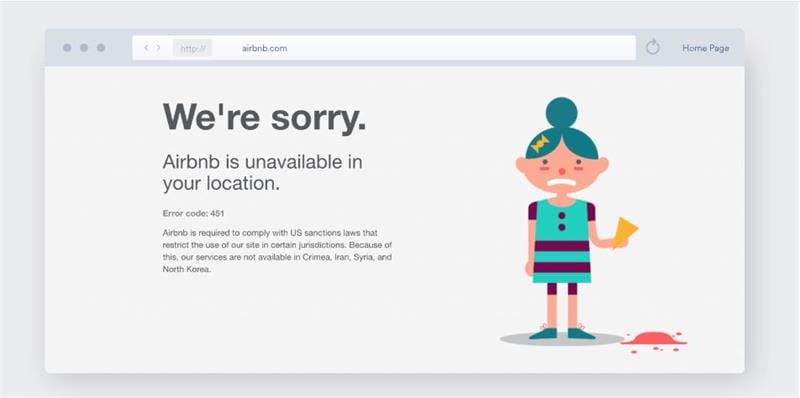
Although Airbnb has been criticized for posing a threat to the availability of low-cost lodging in metropolitan areas, it has proven to be a useful resource for travelers. However, not everyone can use it; for instance, it is unavailable in Iran due to US sanctions.
Part 2. How Does Geo-Blocking Work?
When a firm, rather than a government, is responsible for geoblocking, IP addresses are often the first line of defense. Your IP address is like a street address, revealing where you live.
IP addresses are numerical identifiers that distinguish each machine on the internet. Your computer’s IP address is sent to the server of the website you visit so that it may supply the required data.
You’ll be assigned an IP address when you sign up for an Internet Service Provider. It is possible to pinpoint the location of your device using its IP address, albeit the degree of precision may vary. Websites use the IP address to determine whether you can read their content. They will thus refuse your request if you are using an IP address that’s not on their approved list.
Part 3. Common Types of Geo-blocked Content
The difficulty stems from legal hurdles, including copyrights, licenses, and territorial disputes. Certain streaming services may not make all of their offerings accessible in all regions, or a major online shop may restrict some of their offerings to customers in just one geographic area.
Youtube
Users who upload videos can restrict access to them in certain countries. This nearly usually indicates that a business has chosen that you shouldn’t be able to see a video because of where you are located.

Spotify
You may be trying to find a method to unblock Spotify because you want to listen to unavailable music in your country or because the app has been prohibited in your area.

Live Sports
Big events may be aired exclusively by one company, which means you may be forced to pay to access certain material or go through annoying subscription hoops.

Pandora
Do you want to tune in to this online radio and music station? You can’t access it anywhere in Europe because of a regional firewall.

Porn sites
Artists from porn sites can now geo-block their movies, much like YouTube users do. Some porn sites have been outlawed in several countries, including Egypt and Pakistan, where the vast majority of the population resides.

Amazon
Amazon Prime geo-blocks other services as well as its streaming content. Games, ebooks, software, audiobooks, and other digital materials like TV and movies may be licensed and copyrighted. Amazon Prime prevents certain VPN IPs from accessing foreign content, including Netflix.

Part 4. Tips to Bypass Geo-Blocking
While certain sites may be blocked in your country, there are still methods to access the full functionality of the web. What exactly are they, and how do you go about getting them? Here’s more reading material.
Method 1. Use Smart Domain Name System (DNS)
Clever DNS can evade geoblocking if your smart TV, streaming box, or gaming console doesn’t support VPNs or proxy servers. Some home routers can generate VPN connections, but not all.
By changing your DNS address, clever DNS may alter your device’s virtual location. Smart DNS replaces your Internet provider’s DNS server. Netflix.com’s IP is not netflix.com. You’ll acquire the smart DNS provider’s transparent DNS proxy IP. Netflix thinks you’re in the US since this proxy server is.
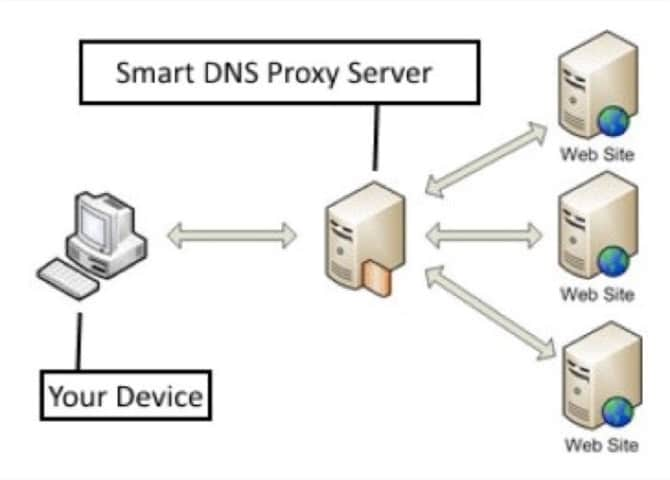
Method 2. Connect to Proxy Servers
Rather than connecting you directly to the server housing the material you want, a proxy server functions as an intermediary. A proxy server does what its name implies: it acts on your behalf to get access to the data and then forwards it to you. Proxy servers, especially those in foreign countries, may be used to get around geographical restrictions.
Depending on the kind of proxy server you use, you may or may not be able to conceal your IP address when surfing the web. Proxy servers are available online and may be accessed from any web browser. Setting up a proxy server is easy, but your activity may still be vulnerable since proxies don’t secure your data.
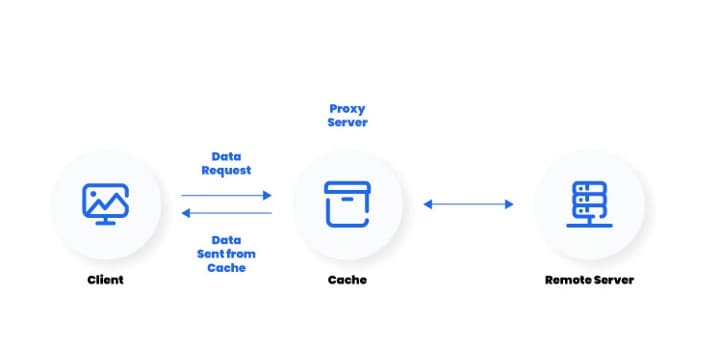
Method 3. Use the Tor Browser
In addition to using a VPN, you may use the anonymous Tor browser. The Tor browser links to the Tor network, a collection of computers that collaborate to conceal your online footprint by relaying your traffic via several intermediary nodes.
Tor employs a technique called “onion routing” to conceal its users’ identities. Since more time is required to traverse these additional levels, your internet speed may suffer as a consequence.
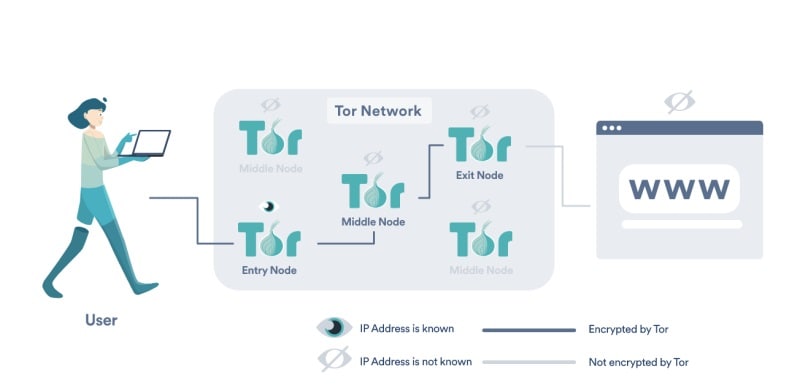
Method 4. A Good VPN Connection
A virtual private network (VPN) may hide your online identity and protect your data by encrypting your connection. VPNs allow you to get around geographically restricted material by redirecting your connection via a server in another country. This will allow you to connect to VPN servers in other countries, such as the United States, the United Kingdom, or Australia.
With effective VPN tools , you can surf the web anonymously, unblock geo-blocked content, and watch your favorite programs abroad. There are several advantages to utilizing a VPN, particularly when you travel or use public Wi-Fi, and they are simple to set up.

Part 5. FAQs About Geo-Blocking
Here are the answers to four questions that you might ask about geo-blocking.
1. Is Geo-Blocking Legal?
Yes. It’s legitimate. Limiting access to websites and services based on a user’s location is lawful. This practice is routinely used in nations like China to prevent citizens from seeing politically sensitive material. Legal arrangements, such as licensing agreements, may also be enforced by geo-blocking.
2. Is Bypassing Geo Blocking Illegal?
It depends. Depending on the situation, the nation, the purpose of the use, and the technique used, geo-blocking circumvention may be against the law. Copyright regulations prohibit users from accessing material beyond its designated location, yet many providers are reluctant to penalize users for doing so.
3. What’s the Difference Between Geo-Fencing and Geo-Blocking?
Geo-fencing is to create digital fences on which to base real-world judgments about where to go. One may draw a boundary around it using longitude and latitude lines on a map to easily establish who is permitted inside a certain region. Restricting access to material based on a user’s physical location is called “geo-blocking.”
4. Is Geo-Restricted the Same as Geo-Blocking?
They are the same. Restricting a user’s ability to access certain online resources depending on their location is known as geo-blocking or geo-restriction. To safeguard their license agreements, foreign media streaming firms often use the practice of geo-blocking.
Conclusion
For several reasons, media and content producers use geo-blocking. Although geo-blocking is unlikely to ever go out of style, there are techniques to circumvent it. Use a virtual private network (VPN) to bypass geo-restrictions on the material you want to watch. Using a Virtual Private Network (VPN), a proxy server, the Tor network, etc., your online location may be hidden or masked.
Geo-blocking controls. It’s both useful and abused. Website banning discriminates and manipulates. Geography may be annoying and frustrating. Sadly, they may always be in style. You don’t have to tolerate them!
Also read:
- [Updated] 2024 Approved Ultimate Top 11 List Excellent Audio Devices
- [Updated] In 2024, A Beginner's Guide to Music in Online Video Footage (FB)
- 2024 Approved Remedy Misidentified Face Photo in Chat Corner
- 3uTools Virtual Location Not Working On Xiaomi Redmi Note 13 Pro+ 5G? Fix Now | Dr.fone
- 5 Best Route Generator Apps You Should Try On Infinix Note 30 5G | Dr.fone
- 6 Ways to Change Spotify Location On Your Vivo Y78+ | Dr.fone
- 8 Solutions to Fix Find My Friends Location Not Available On Realme V30 | Dr.fone
- Exploring the Features and Performance of the Standout Mid-Range Marvel, Motorola One Hyper
- How To Unlock Apple iPhone 7 Plus 3 Ways To Unlock
- Lock Your Nubia Red Magic 9 Pro+ Phone in Style The Top 5 Gesture Lock Screen Apps
- Navigating the World of Electronics with Tom's Advice
- Top Videobearbeitungstools Für PCs Mit Windows 11, 8 Oder 7: Umfassende Bildschirmaufnahmeoptionen
- Updated Contemporary Techniques for Crafting Effective Audio Echoes for 2024
- Title: A Detailed VPNa Fake GPS Location Free Review On Xiaomi Redmi K70 Pro | Dr.fone
- Author: Mia
- Created at : 2025-01-14 19:29:20
- Updated at : 2025-01-15 22:36:34
- Link: https://location-fake.techidaily.com/a-detailed-vpna-fake-gps-location-free-review-on-xiaomi-redmi-k70-pro-drfone-by-drfone-virtual-android/
- License: This work is licensed under CC BY-NC-SA 4.0.